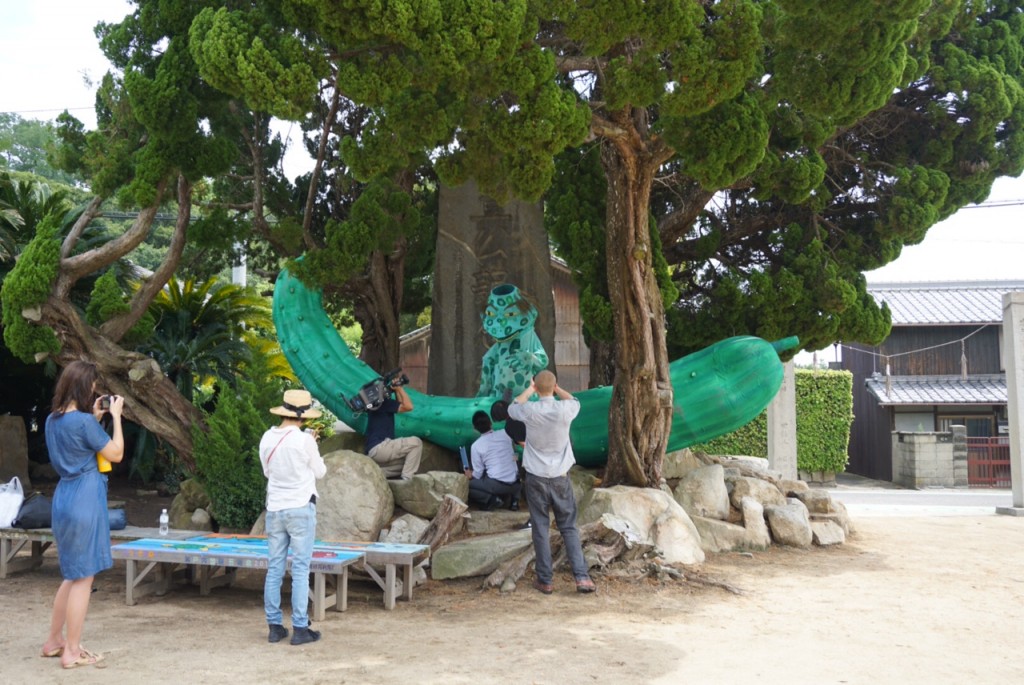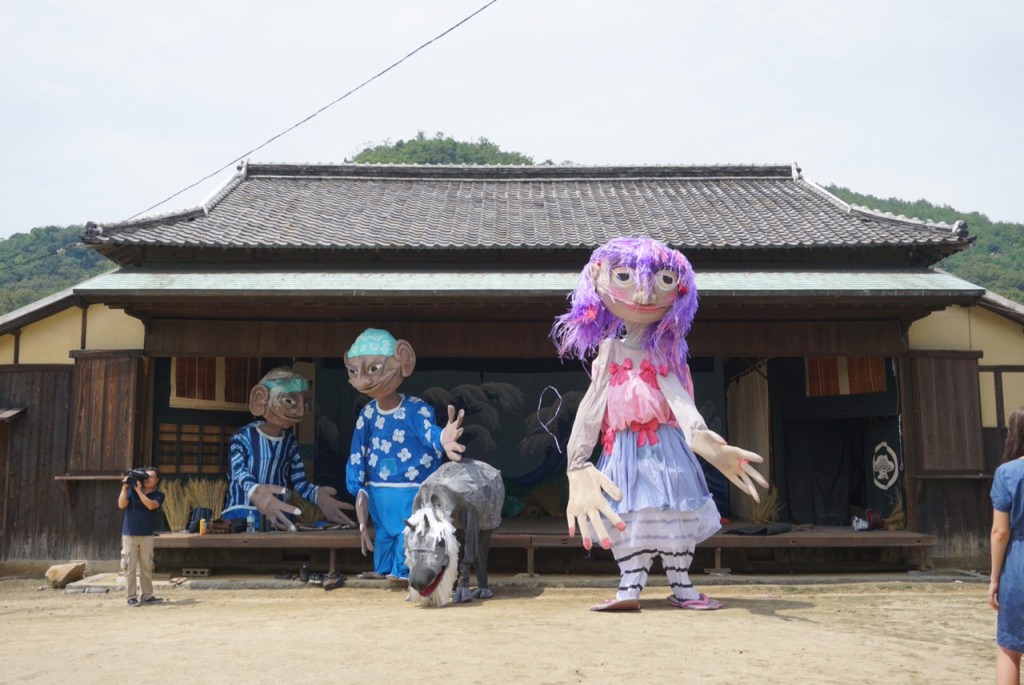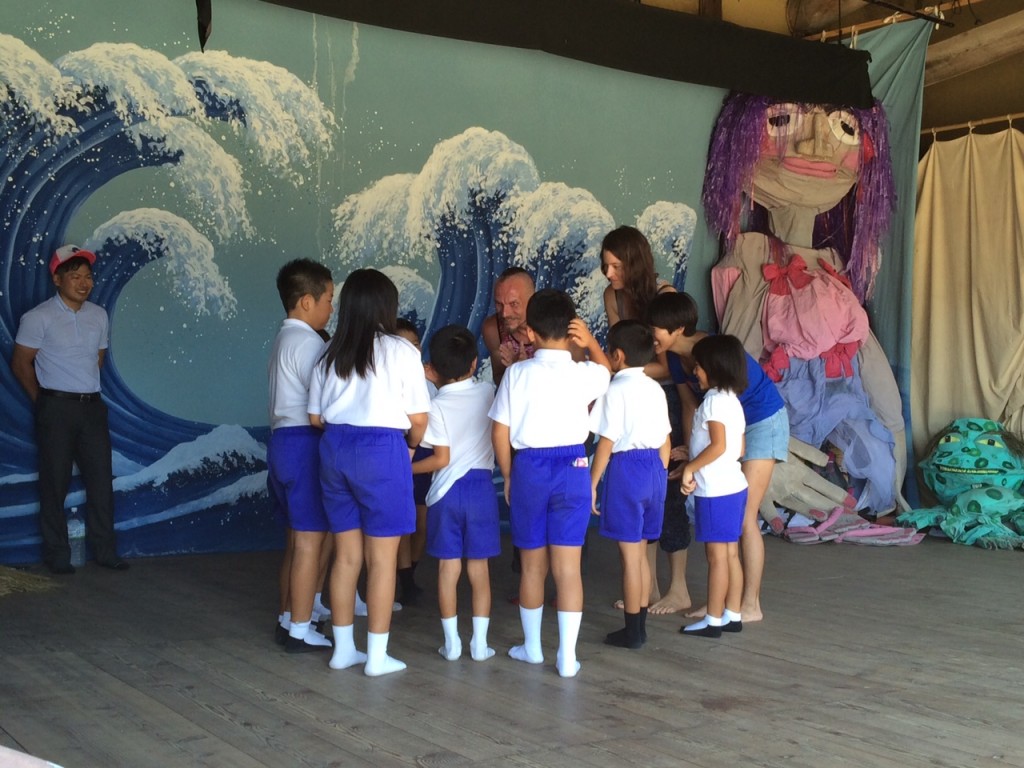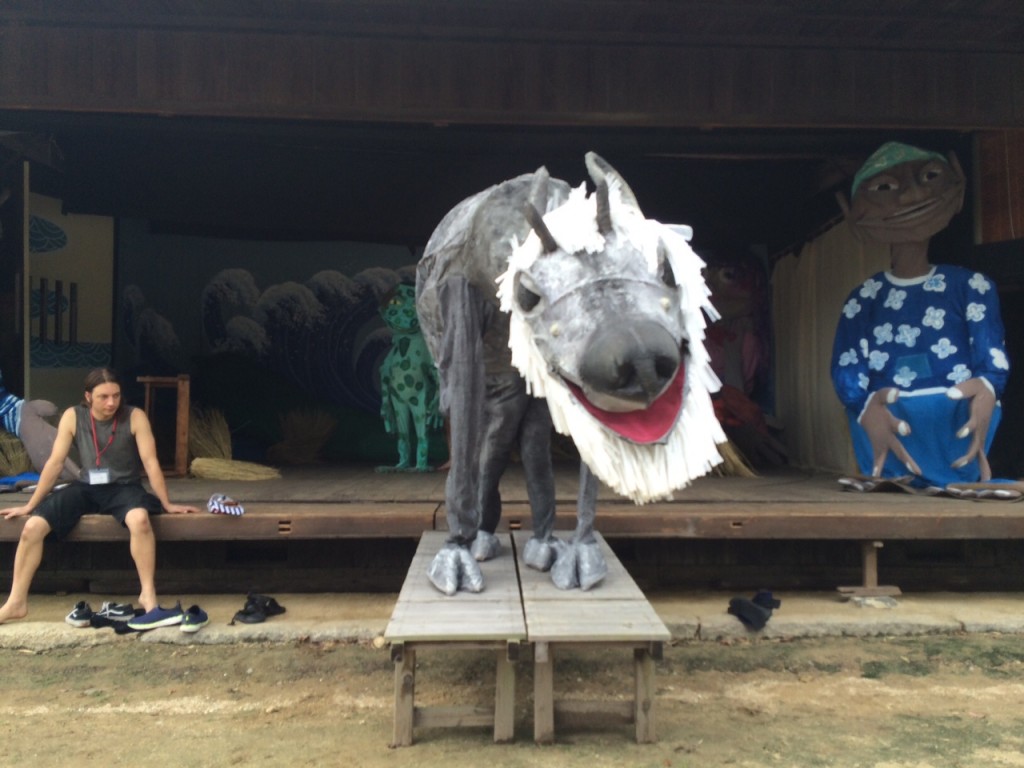Part Three of Nick Wilson‘s Japan diary:
The final stage of our Japan trip was a week-long visit to Honjima Island, to exhibit puppets, meet the community, run some workshops, make some guest appearances on the mainland, and to present a feature performance in the island’s disused Kabuki theatre.
While statistically the communities of Urada and Honjima might look similar in some ways, we all felt a definite shift in the atmosphere on moving from Urada’s endless green mountains and rice-fields to this small-island fishing village on the Seto Inland Sea. During the ferry trip across, Japan’s longest bridge appeared to neither start nor end, but to bypass the island and disappear in ocean mist on its way somewhere else. Parts of the island are quite visibly abandoned, neglected and overgrown: weeds grow through cracked concrete, and the salty air turns metal fixtures into flaky brown rust before their time. Honjima’s population has fallen from 4000 in the 1960’s to 400 today, of which only 20 are school-aged children. It is one of 12 islands that are host to the region’s Setouchi Art Triennale, another ambitious and immense project by Fram Kitagawa to revitalise dwindling regions through the arts.
Our venue was Chito Tse-za, a beachside Kabuki theatre dated to 1862, and barely opened in the last thirty years. A fine example of the smart simplicity of traditional Japanese construction, the front panels slide open to either side of the building, and the waist-high rails fold outward to form an extension of the stage, which the audience views from outside in a public courtyard. We were instantly charmed by its elegant design, skilful construction and dilapidated ambience. It seemed an ideal gateway into that parallel, slightly surreal world that our puppets often inhabit: where the impossible and the dreamlike can invade mundane streets; where the fictional ‘puppet world’ shares an open boundary with the lives of our audience.
We displayed our puppets in the open theatre for three days, meeting with residents, visitors and the press, and working out a story that would resonate in this new context. As we loaded in to our new space, the Chito Tse-za theatre straight away provided us with an impressive image: the upturned cucumber, the full width of the stage up against a towering backdrop of classic painted waves, their curves almost perfectly matched. We straddled Kappa over it, and instantly he was riding the cucumber across the ocean like it’s a giant bucking sea-mule.
The islands suffer not just from departing families and too few children but also from shortage of fresh water. So in the Honjima version of our show the Kappa was a greedy water-thief, riding his cucumber between the islands and stealing their fresh water to continue to feed it. Magomusume catches the ferry home for a visit and sees him making his way over to Honjima. She is the catalyst for change, mobilising the animals and villagers into creating an equitable bargain.
We squeezed quite a bit into our week. We found ourselves performing at a massive group-dance festival in Marugame, with hundreds of 20-piece ensembles each powering through colourful-costumed routines to unrelenting pop over five stages. Our puppets were definitely the odd ones out at that event. Then Honjima’s 10 primary-aged kids came to our workshop to devise a couple of scenes using sound and movement, to be performed in the rice-straw costumes. It was a totally new experience for them, and I wished I could understand what they were saying afterwards when being interviewed by a television crew about the experience.
We were treated to a very rare and beautiful group chanting-circle by some local old ladies, which Rosalind and Amiel carefully documented. We were floored by the power and energy of the young Taiko group at their weekly practice, and after instructing us how to play through a few rhythms (a very satisfying feeling on those massive instruments) a couple of talented teenagers agreed to add live drumming to the show. We had some chances to film the puppets in interesting settings, and were visited by a number of TV crews, with puppets and interviews featured on four different television programs.
We cast two new people in the Jisa and Kamoshka puppets, and trained up our crew of super-keen cucumber wranglers. All the while we’re checking the satellite images of two nearby Typhoons, one due to hit us on show day and threatening to jeopardize everything. It was heartbreaking to have to think about a contingency venue for wet weather.
Luckily the whole thing was quite anti-climactic, and a last minute date-change paid off, avoiding the rain, wind and ferry closures. We got to use Chito Tse-za, and the show attracted over one hundred people to the theatre. Reactions and feedback were excellent, and luckily for us, the villagers seemed very keen to host us again.
This whole project was pretty ambitious as always, and we’ve achieved a lot together with our many collaborators, but our feeling is that we’ve just begun out here. There are so many elements at play, so much deeper to dig. Obon Festival allowed us to see our Urada group in a different light, with amazing performances from local singers and musicians, including a 12-piece incarnation of the Seppuchu Pistols, who totally blew us away with their immense rhythmic energy. There are so many stories that we’ve only touched on, so many more voices to hear: we’d love to get inside Urada’s nursing home, spend more time talking to the children of Honjima, get to the bottom of the Kappa story, find the mythic Shirikodama. It’s also our first time properly working with film, not just as documentation but as a performance medium, and there are some moments of magic in these rushes that need some space and thought to flower into something. There is so much more of Chito Tse-za to play with and to show the world. It can’t be beyond us to get that rotating stage spinning again!
Besides all that, we already have phase one of a great show sitting, waiting for us in Japan, so the temptation is also there to pick up our Urada crew and take them on tour. We couldn’t mentally switch off during our transit through Tokyo; we kept visualising this or that scene in different parts of the city; Magomusume in her element, dancing in the streetlights of Shibuya; the animals juxtaposed like a call to the wild, a distant dream from childhood. This time, maybe the country Grandparents visit her. It’s nice to see them, but there is not enough room in her apartment. It’s too crowded, they get anxiety crashing into pedestrians. The Kyurie drives around on the back of a truck, or appears on a rooftop, or is paraded by white-shirted commuters or swung from a great height. Kappa makes the most of the anonymity of crowds, and gets up to all kinds of mischief.
The whole idea so far has been to get people into these remote areas, to stimulate communities and revitalise entire regions; it has been amazing to be a part of and to see for ourselves. But we can’t help but feel that bringing a community-made work like this to the city would also be amazing on so many levels, as an experience for the participants, as a surprise for unsuspecting new audiences, as unprecedented publicity for the entire event: its purpose, and its achievements.
We owe a massive thanks to Asialink Arts, Echigo-Tsumari Art Triennale, Setouchi Triennale, and the Australian Embassy, Tokyo for their support and vision, and of course to all our helpers, participants, staff, volunteers and collaborators along the way.
And thanks to you all for reading, please stay tuned for updates and some amazing footage.
Until next time,
from Nick & the SP Japan team.
This is an Asialink Arts Residency Project supported by the Australia-Japan Foundation and the Australian Embassy, Tokyo.








